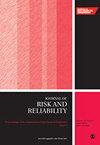基于属性贝叶斯控制图的最优状态维修
IF 1.7
4区 工程技术
Q3 ENGINEERING, INDUSTRIAL
Proceedings of the Institution of Mechanical Engineers Part O-Journal of Risk and Reliability
Pub Date : 2023-05-25
DOI:10.1177/1748006x231174960
引用次数: 0
摘要
基于状态的维修(CBM)已成为维修管理的一个相对较新的趋势。CBM程序不是在规定的时间间隔内进行预防性维护操作,而是通过状态监测收集信息,然后根据观察到的数据推荐维护操作。另一方面,贝叶斯控制图使用系统处于不健康状态的后验概率作为图表统计量。基于连续齐次马尔可夫链,本文采用属性贝叶斯控制图对退化系统进行监测,并制定CBM行动计划。系统状态分为健康状态、不健康状态和失败状态。提出了一种部分可观察马尔可夫决策过程(POMDP),该决策过程可以最优地确定样本量、采样间隔和预警极限,以最小化每时间单位的长期预期成本。通过数值算例和灵敏度分析,阐明了所提出的属性控制图的性能。据作者所知,这是属性贝叶斯控制图在基于状态的维护中的应用的第一个研究。本文章由计算机程序翻译,如有差异,请以英文原文为准。
Optimal condition based maintenance using attribute Bayesian control chart
Condition-based maintenance (CBM) has been emerged as a relatively new trend in maintenance management. Instead of conducting preventive maintenance actions in specified time intervals, the CBM program collects information through condition monitoring, then recommends maintenance actions based on the observed data. On the other hand, Bayesian control charts use the posterior probability of being the system in an unhealthy state as the chart statistic. An attribute Bayesian control chart is employed in this study to monitor a deteriorating system and plan CBM actions based on a continuous-time homogeneous Markov chain. The system consists of three states: healthy, unhealthy, and failure states. A partially observable Markov decision process (POMDP) is developed, which optimally determines the sample size, sampling interval, and warning limit to minimize the long-term expected cost per time unit. Numerical examples and sensitivity analyses are conducted to clarify the performance of the proposed attribute control chart. To the best of the authors’ knowledge, this is the first study of the applications of attribute Bayesian control charts in condition-based maintenance.
求助全文
通过发布文献求助,成功后即可免费获取论文全文。
去求助
来源期刊

Proceedings of the Institution of Mechanical Engineers Part O-Journal of Risk and Reliability
ENGINEERING, MULTIDISCIPLINARY-ENGINEERING, INDUSTRIAL
CiteScore
4.50
自引率
19.00%
发文量
81
审稿时长
6-12 weeks
期刊介绍:
The Journal of Risk and Reliability is for researchers and practitioners who are involved in the field of risk analysis and reliability engineering. The remit of the Journal covers concepts, theories, principles, approaches, methods and models for the proper understanding, assessment, characterisation and management of the risk and reliability of engineering systems. The journal welcomes papers which are based on mathematical and probabilistic analysis, simulation and/or optimisation, as well as works highlighting conceptual and managerial issues. Papers that provide perspectives on current practices and methods, and how to improve these, are also welcome
 求助内容:
求助内容: 应助结果提醒方式:
应助结果提醒方式:


